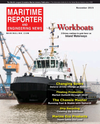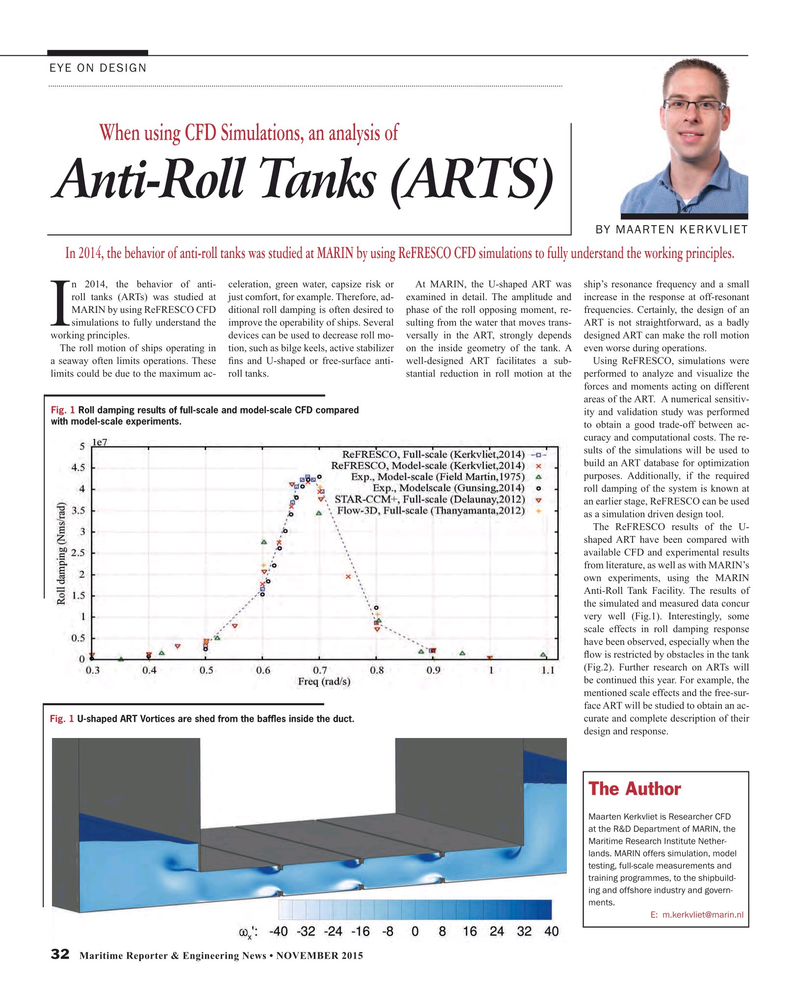
Page 32: of Maritime Reporter Magazine (November 2015)
Workboat Edition
Read this page in Pdf, Flash or Html5 edition of November 2015 Maritime Reporter Magazine
EYE ON DESIGN
When using CFD Simulations, an analysis of
Anti-Roll Tanks (ARTS)
BY MAARTEN KERKVLIET
In 2014, the behavior of anti-roll tanks was studied at MARIN by using ReFRESCO CFD simulations to fully understand the working principles.
n 2014, the behavior of anti- celeration, green water, capsize risk or At MARIN, the U-shaped ART was ship’s resonance frequency and a small roll tanks (ARTs) was studied at just comfort, for example. Therefore, ad- examined in detail. The amplitude and increase in the response at off-resonant
MARIN by using ReFRESCO CFD ditional roll damping is often desired to phase of the roll opposing moment, re- frequencies. Certainly, the design of an
Isimulations to fully understand the improve the operability of ships. Several sulting from the water that moves trans- ART is not straightforward, as a badly working principles. devices can be used to decrease roll mo- versally in the ART, strongly depends designed ART can make the roll motion
The roll motion of ships operating in tion, such as bilge keels, active stabilizer on the inside geometry of the tank. A even worse during operations.
a seaway often limits operations. These ? ns and U-shaped or free-surface anti- well-designed ART facilitates a sub- Using ReFRESCO, simulations were limits could be due to the maximum ac- roll tanks. stantial reduction in roll motion at the performed to analyze and visualize the forces and moments acting on different areas of the ART. A numerical sensitiv-
Fig. 1 Roll damping results of full-scale and model-scale CFD compared ity and validation study was performed with model-scale experiments.
to obtain a good trade-off between ac- curacy and computational costs. The re- sults of the simulations will be used to build an ART database for optimization purposes. Additionally, if the required roll damping of the system is known at an earlier stage, ReFRESCO can be used as a simulation driven design tool.
The ReFRESCO results of the U- shaped ART have been compared with available CFD and experimental results from literature, as well as with MARIN’s own experiments, using the MARIN
Anti-Roll Tank Facility. The results of the simulated and measured data concur very well (Fig.1). Interestingly, some scale effects in roll damping response have been observed, especially when the ? ow is restricted by obstacles in the tank (Fig.2). Further research on ARTs will be continued this year. For example, the mentioned scale effects and the free-sur- face ART will be studied to obtain an ac- curate and complete description of their
Fig. 1 U-shaped ART Vortices are shed from the baf? es inside the duct.
design and response.
The Author
Maarten Kerkvliet is Researcher CFD at the R&D Department of MARIN, the
Maritime Research Institute Nether- lands. MARIN offers simulation, model testing, full-scale measurements and training programmes, to the shipbuild- ing and offshore industry and govern- ments.
E: [email protected] 32 Maritime Reporter & Engineering News • NOVEMBER 2015
MR #11 (26-33).indd 32 11/3/2015 11:34:14 AM

 31
31

 33
33
